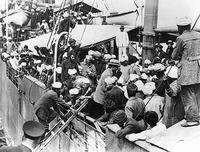Komagata Maru
KOMAGATA MARU was a Japanese steamer chartered in 1914 for $66,000 by Gurdit Singh Sarhali, a SIKH entrepreneur, to bring a group of prospective SOUTH ASIAN immigrants, mainly Sikhs, to Canada from the Far East. The venture was intended to challenge restrictive Canadian immigration policies requiring new arrivals from India to take direct passage to Canada; in practice no direct passage from India was available. When the vessel arrived in VANCOUVER harbour on 23 May 1914, officials refused to allow the 376 passengers to disembark, except for 22 returning to Canada. The South Asian community was adamant that the newcomers be allowed to land, but public sentiment was mostly against them and the authorities insisted that the ship should return to India.
Conditions on board deteriorated as supplies of food and drinking water dwindled. On 28 June a case was heard in court to test the regulations; it upheld the government, which ordered the ship out of the harbour. When the Komagata Maru failed to leave, Malcolm Reid, a local immigration official, led 125 armed police officers and 35 ex-military men on the tug Sea Lion in an unsuccessful attempt to board the ship. Finally the federal government called in the naval cruiser Rainbow; with its appearance the Komagata Maru departed on 23 July. When the ship arrived in Calcutta, British officials attempted to arrest Gurdit Singh, touching off a riot in which 20 people died and many more were arrested.
In Vancouver the incident divided and angered the South Asian community and led to a series of shootings as individuals took revenge on police informants. In Oct a member of the Sikh community, Mewa Singh, assassinated William HOPKINSON, an immigration inspector. Singh was executed for the murder; the Sikh community still honours him as a martyr.
In 1989 a stone lion was installed in Portal Park, Vancouver, to mark the 75th anniversary of the incident.
Reading: Hugh J.M. Johnston, The Voyage of the Komagata Maru, 1979.

